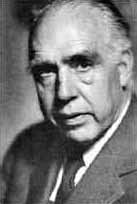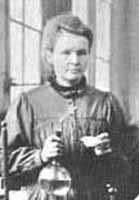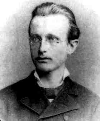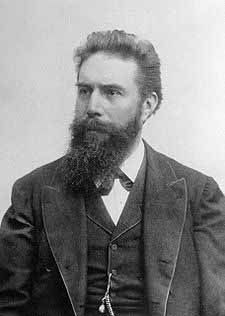Albert Einstein

Physicist and Mathematician
Nobel Laureate for Physics 1921
"There are only two ways to live your life.
One is as though nothing is a miracle.
The other is as if everything is."
- Albert Einstein -
Albert Einstein was a German-born theoretical physicist who is widely considered one of the greatest physicists of all time.
While best known for the theory of relativity (and specifically mass-energy equivalence, E=mc2), he was awarded the 1921 Nobel Prize in Physics for his 1905 (Annus Mirabilis) explanation of the photoelectric effect and "for his services to Theoretical Physics". In popular culture, the name "Einstein" has become synonymous with great intelligence and genius. Einstein was named Time magazine's "Man of the Century."
He was known for many scientific investigations, among which were: his special theory of relativity which stemmed from an attempt to reconcile the laws of mechanics with the laws of the electromagnetic field, his general theory of relativity which extended the principle of relativity to include gravitation, relativistic cosmology, capillary action, critical opalescence, classical problems of statistical mechanics and problems in which they were merged with quantum theory, leading to an explanation of the Brownian movement of molecules; atomic transition probabilities, the probabilistic interpretation of quantum theory, the quantum theory of a monatomic gas, the thermal properties of light with a low radiation density which laid the foundation of the photon theory of light, the theory of radiation, including stimulated emission; the construction of a unified field theory, and the geometrization of physics.
Einstein was born on March 14, 1879, to a Jewish family, in Ulm, Württemberg, Germany. His father was Hermann Einstein, a salesman who later ran an electrochemical works, and his mother was Pauline née Koch. They were married in Stuttgart-Bad Cannstatt.
At his birth, Albert's mother was reputedly frightened that her infant's head was so large and oddly shaped. Though the size of his head appeared to be less remarkable as he grew older, it's evident from photographs of Einstein that his head was disproportionately large for his body throughout his life, a trait regarded as "benign macrocephaly" in large-headed individuals with no related disease or cognitive deficits. His parents also worried about his intellectual development as a child due to his initial language delay and his lack of fluency until the age of nine, though he was one of the top students in his elementary school.
In 1880, shortly after Einstein's birth the family moved to Munich, where his father and his uncle founded a company manufacturing electrical equipment (Elektrotechnische Fabrik J. Einstein & Cie). This company provided the first lighting for the Oktoberfest as well as some cabling in the suburb of Schwabing.
-----
Niels Bohr

Bohr was born in Copenhagen, Denmark in 1885. His father, Christian Bohr, a devout Lutheran, was professor of physiology at the University of Copenhagen (it is his name which is given to the Bohr shift or Bohr effect), while his mother, Ellen Adler Bohr, came from a wealthy Jewish family prominent in Danish banking and parliamentary circles. His brother was Harald Bohr, a mathematician and Olympic footballer who played on the Danish national team. Niels Bohr was a passionate footballer as well, and the two brothers played a number of matches for the Copenhagen-based Akademisk Boldklub.
In 1903 Bohr enrolled as an undergraduate at Copenhagen University, initially studying philosophy and mathematics. In 1905, prompted by a gold medal competition sponsored by the Danish Academy of Sciences and Letters, he conducted a series of experiments to examine the properties of surface tension, using his father's laboratory in the university, familiar to him from assisting there since childhood. His essay won the prize, and it was this success that decided Bohr to abandon philosophy and adopt physics.
As a student under Christian Christiansen he received his doctorate in 1911. As a post-doctoral student, Bohr first conducted experiments under J. J. Thomson at Trinity College, Cambridge. He then went on to study under Ernest Rutherford at the University of Manchester in England. On the basis of Rutherford's theories, Bohr published his model of atomic structure in 1913, introducing the theory of electrons traveling in orbits around the atom's nucleus, the chemical properties of the element being largely determined by the number of electrons in the outer orbits. Bohr also introduced the idea that an electron could drop from a higher-energy orbit to a lower one, emitting a photon (light quantum) of discrete energy. This became a basis for quantum theory.
Niels Bohr and his wife Margrethe Nørlund had six children. Two died young, and most of the others went on to lead successful lives. One, Aage Niels Bohr, also became a very successful physicist; like his father, he won a Nobel Prize in 1975.
-----
Marie Curie

Her achievements include the creation of a theory of radioactivity (a term coined by her), techniques for isolating radioactive isotopes, and the discovery of two new elements, polonium and radium. It was also under her personal direction that the world's first studies were conducted into the treatment of neoplasms ("cancers"), using radioactive isotopes.
While an actively loyal French citizen, she never lost her sense of Polish identity. She named the first new chemical element that she discovered (1898) "polonium" for her native country, and in 1932 she founded a Radium Institute in her home town Warsaw, headed by her physician-sister Bronislawa.
In 1896 Henri Becquerel discovered that uranium salts emitted rays that resembled X-rays in their penetrating power. He demonstrated that this radiation, unlike phosphorescence, did not depend on an external source of energy but seemed to arise spontaneously from uranium itself. Becquerel had in fact discovered radioactivity. Marie decided to look into uranium rays as a possible field of research for a thesis. She used a clever technique to investigate samples.
Fifteen years earlier, her husband and his brother had invented the electrometer, a device for measuring extremely low electrical currents. Using the Curie electrometer, she discovered that uranium rays caused the air around a sample to conduct electricity. Her first result, using this technique, was the finding that the activity of the uranium compounds depended only on the amount of uranium present. She had shown that the radiation was not the outcome of some interaction between molecules but must come from the atom itself. In scientific terms, this was the most important single piece of work that she carried out.
Marie's systematic studies had included two uranium minerals, pitchblende and torbernite. Her electrometer showed that pitchblende was four times as active as uranium itself, and chalcolite twice as active. She concluded that, if her earlier results relating the amount of uranium to its activity were correct, then these two minerals must contain small amounts of some other substance far more active than uranium itself.
-----
Max Planck

Max Karl Ernst Ludwig Planck was born on 23 April in Kiel Germany. He was the sixth child in a family devoted to the church and state. His father was a prominent jurist and professor of law at the University of Kiel. At the age of 9, his father received a post at the University of Munich, and Planck attended the Maximilian Gymnasium. While there Planck succeeded very well in all subjects and he gained an interest in physics and mathematics finally graduating at the age of 17.
He found it difficult to make a decision on what career he was going to aim for, finally settling for physics rather than music or classical philogy, since he believed he had his greatest originality within that physics. He was an excellent pianist and found great pleasure in playing, having the gift of absolute pitch. Another passion of his was hiking, mountain climbing and taking long walks as regularly as possible.
In 1874 Planck entered the University of Munich, and was unimpressed with his physics professor there, Professor Phillip von Jolly. He did, however, find intellectual stimulation through self study. Planck was deeply impressed by the law of conservation of energy and he became convinced that the second law of termodynamics was an absolute law of nature.
Planck based his doctoral dissertation on the second law of thermodynamics and in July 1879, at the young age of 21 he received his doctoral degree. Following this he completed his qualifying dissertation at Munich and he employed as a lecturer (Privatdozent). With the help of his father in 1885 he took up the position of associate professor at the University of Kiel becoming a full professor in 1892 at the University of Berlin when Kirchoff died. Planck lectured on all branches of theoretical physics and had nine doctoral students study under him.
Planck was intrigued by the law discovered by his colleague Wilhelm Wien in 1896. He made several attempts at deriving this law, starting from the second law of thermodynamics as a base Experimental evidence was coming to light which showed that Wiens law broke down completely at low frequencies but was perfectly viable at high frequencies.
Plank guessed that, since the entropy of radiation depended mathematically on it's energy in the high frequency range due to Wiens law, and that because he knew what the dependance was in the low frequency region, he should somehow combine these two properties in some simple manner resulting in a formula relating frequency, to the energy of radiation. The formula was hailed a great success, but Planck noted that it was just a formula; a lucky guess which still had to be derived from first principles inorder to give it a proper scientific standing.
In 1900, at the age of 42, Planck achieved this, but in the process he had to abandon one of his greatest beliefs - that the second law of thermodynamics was an absolute law of nature. He was forced to accept Ludwig Boltzmann's statistical explanation for the second law. Planck also had to assume that the black body oscillators could only absorb and emit energy in discrete amounts of energy - packets of energy which he called quanta. Only by carrying out a statistical analysis of these quanta of energy could Planck derive his formula.
Each quanta contained an energy directly proportional to a constant, h, multiplied by the frequency of oscillation of the particular blackbody oscillator associated with that quanta. Using his formula he calculated a value for Boltzmanns constant, Avogadros numer, the charge of the electron as well as the constant h. As time passed others came to realise that because of the finite, non-zero value of h, the world at atomic dimensions could not be explained with classical mechanics. The quantum age had truly begun!
-----
Wilhelm Conrad Rontgen

Rontgen, Wilhelm Conrad - born March 27, 1845, Lennep, Prussia [now Remscheid, Ger.] d. Feb. 10, 1923, Munich - German physicist who was a recipient of the first Nobel Prize for Physics, in 1901, for his discovery of X rays, which heralded the age of modern physics and revolutionized diagnostic medicine.
Rontgen studied at the Polytechnic in Zürich and then was professor of physics at the universities of Strasbourg (1876-79), Giessen (1879-88), Wurzburg (1888-1900), and Munich (1900-20). His research also included work on elasticity, capillary action of fluids, specific heats of gases, conduction of heat in crystals, absorption of heat by gases, and piezoelectricity.
In 1895, while experimenting with electric current flow in a partially evacuated glass tube (cathode-ray tube), Röntgen observed that a nearby piece of barium platinocyanide gave off light when the tube was in operation.
He theorized that when the cathode rays (electrons) struck the glass wall of the tube, some unknown radiation was formed that traveled across the room, struck the chemical, and caused the fluorescence.
Further investigation revealed that paper, wood, and aluminum, among other materials, are transparent to this new form of radiation. He found that it affected photographic plates, and, since it did not noticeably exhibit any properties of light, such as reflection or refraction, he mistakenly thought the rays were unrelated to light.
In view of its uncertain nature, he called the phenomenon X-radiation, though it also became known as Rontgen radiation.
He took the first X-ray photographs, of the interiors of metal objects and of the bones in his wife's hand.
No comments:
Post a Comment